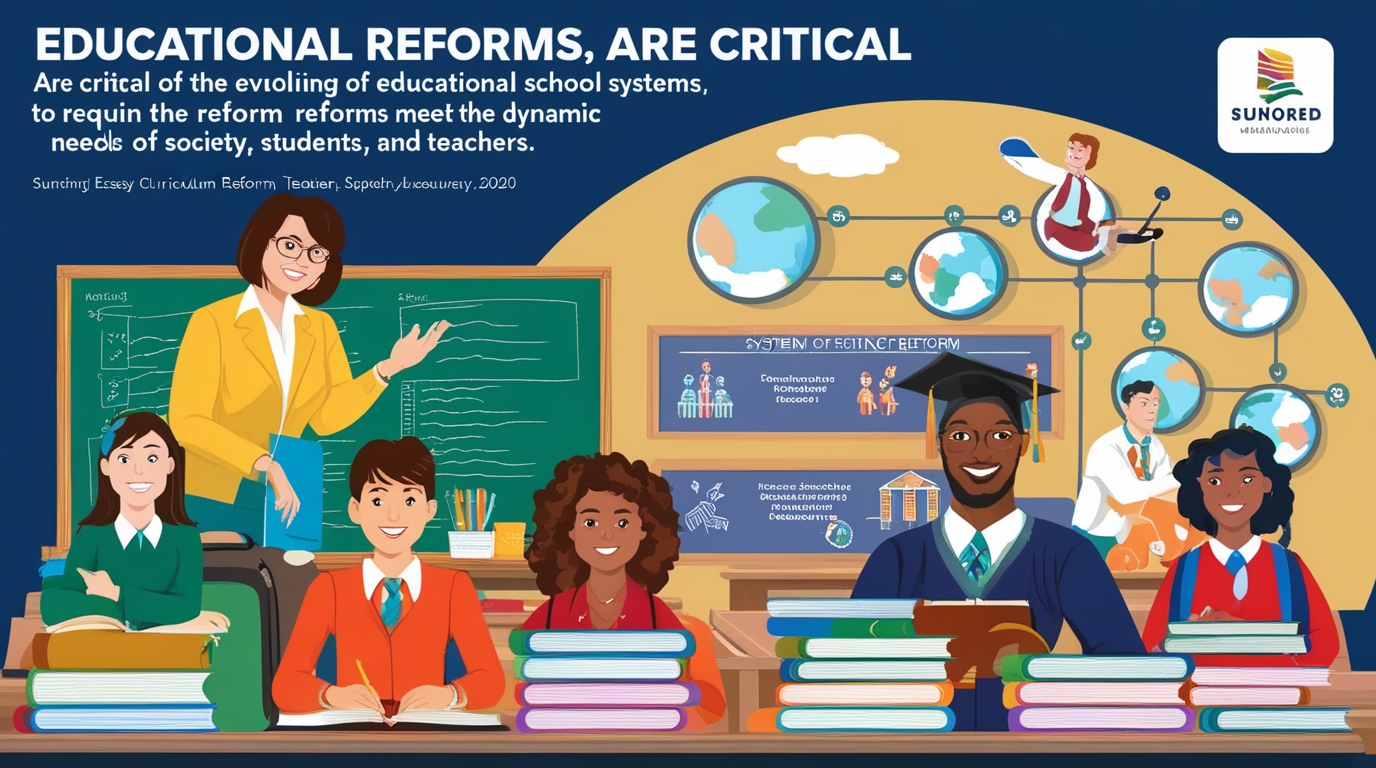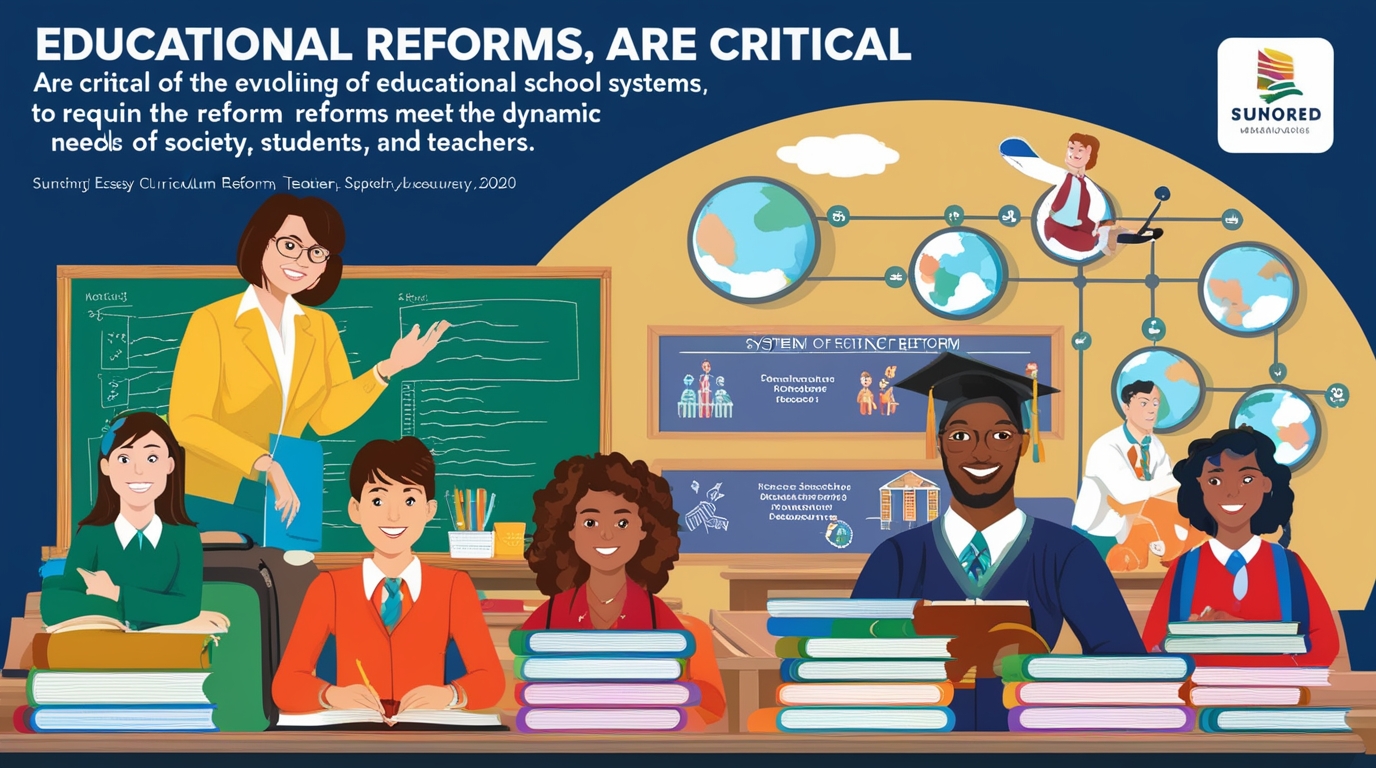Educational reforms are critical for evolving school systems to meet the dynamic needs of society, students, and teachers. Schools, being the bedrock of education, require reform to remain relevant and effective. The concept of reforming education isn’t new; historically, systems have been altered in response to changing societal needs, economic demands, and pedagogical philosophies. This essay will delve into the various aspects of educational reform in schools, focusing on curriculum overhaul, teacher training, assessment methods, infrastructure, and inclusivity.
1. Curriculum Overhaul
One of the primary targets of educational reform is the curriculum. The curriculum determines what students learn, how they learn, and the knowledge and skills they acquire. Traditionally, many curriculums have focused on rote memorization and standardized testing. However, these methods are increasingly viewed as inadequate for preparing students for real-world challenges, such as critical thinking, problem-solving, and adaptability.
Reforming the Curriculum
A reformed curriculum should focus on holistic development, integrating academic knowledge with life skills, emotional intelligence, and creativity. Subjects like financial literacy, coding, environmental science, and global citizenship should be introduced. This would prepare students not only for academic success but also for a globalized world that requires adaptability and innovation. Additionally, reforms should emphasize interdisciplinary learning, where subjects like math, science, and social studies are taught in interconnected ways to show students the real-world application of their knowledge.
Furthermore, incorporating technology into the curriculum is essential. In the 21st century, digital literacy is as fundamental as reading or math. Students should be equipped with skills in information technology, coding, and digital communication. Schools should adopt digital tools such as simulations, virtual labs, and online platforms that make learning more engaging and interactive.
2. Teacher Training and Development
No educational reform can be effective without addressing teacher training. Teachers are the most influential figures in a student’s academic journey. Their methods, knowledge, and interaction with students shape the learning environment. Historically, many teachers have relied on traditional methods such as lecturing and rigid assessments, which may not meet the diverse needs of today’s students.
Professional Development
Teachers should undergo continuous professional development to stay updated with the latest educational research and technological tools. Training programs should include workshops on active learning strategies, differentiated instruction, and classroom management techniques. By learning innovative teaching methods, teachers can create a more engaging and inclusive learning environment.
Additionally, teacher training should focus on emotional and psychological support for students. Many students face mental health challenges, and teachers need the skills to recognize, address, and support these issues in the classroom. Emotional intelligence training will help teachers understand the emotional needs of students and create a more empathetic and inclusive environment.
Reforming Teacher Assessments
Another aspect of teacher reform is reevaluating how teacher performance is measured. Current methods often focus on students’ standardized test results, which may not accurately reflect a teacher’s effectiveness. A more holistic approach would include peer reviews, self-assessments, and classroom observations by educational experts. Such evaluations can provide a better understanding of the teachers’ strengths and areas that need improvement.
3. Assessment and Evaluation Methods
Assessment reform is another critical element of educational change. The current system, which emphasizes standardized tests, has been widely criticized for encouraging rote learning and limiting creativity. In addition, this method often causes stress and anxiety among students, affecting their mental health and overall development.
Moving Beyond Standardized Testing
A reformed assessment system should focus on a more comprehensive approach to evaluating students’ abilities. This could include project-based assessments, portfolios, and presentations, which allow students to demonstrate their understanding and skills in diverse ways. Such assessments provide a better understanding of a student’s ability to apply their knowledge in practical situations.
Moreover, formative assessments—ongoing checks of student understanding—should be prioritized over summative assessments that occur at the end of the term or year. Formative assessments allow teachers to track student progress continuously and adjust their teaching methods accordingly. This ensures that learning gaps are addressed early, giving students the chance to improve before the final evaluation.
Incorporating Soft Skills in Assessment
Reforms should also focus on assessing non-academic skills like teamwork, communication, problem-solving, and emotional intelligence. These “soft skills” are crucial for success in the modern workforce and should be recognized and developed in school. Group projects, leadership roles, and classroom discussions can be evaluated to measure these abilities, encouraging students to develop a well-rounded skill set.

4. Infrastructure and Resources
For educational reforms to be effective, schools must be equipped with modern infrastructure and resources. Unfortunately, many schools, particularly in underprivileged areas, lack basic facilities such as libraries, science labs, and computer rooms. This imbalance in resources perpetuates educational inequality, where students in better-funded schools have far more opportunities than those in resource-poor schools.
Upgrading Facilities
Reforms should focus on upgrading school infrastructure to create environments conducive to learning. This includes well-equipped classrooms, libraries, science and technology labs, and sports facilities. A special focus should be on integrating technology into classrooms, with schools providing students with access to computers, tablets, and reliable internet connections.
Sustainable Schools
Another aspect of infrastructure reform is creating sustainable, eco-friendly schools. By incorporating green practices such as solar panels, energy-efficient lighting, and recycling programs, schools can serve as role models for students, teaching them about environmental responsibility while also reducing operational costs.
5. Inclusivity and Equal Opportunities
Education should be accessible and equitable for all students, regardless of their background, gender, or abilities. However, many schools still struggle with issues related to inclusivity, including gender disparities, discrimination, and inadequate support for students with special needs.
Gender Equality
In many parts of the world, gender biases continue to impact students’ access to education. Reforms should focus on creating gender-sensitive curriculums and school environments where both boys and girls have equal opportunities to succeed. Encouraging more girls to pursue STEM (Science, Technology, Engineering, and Mathematics) subjects and leadership roles in school can help combat gender stereotypes.
Supporting Students with Special Needs
Inclusive education also means ensuring that students with special needs are given the support they require to thrive. This involves providing specialized training for teachers, employing special education experts, and offering appropriate resources such as assistive technologies. Moreover, schools should aim to integrate students with disabilities into mainstream classrooms to promote social inclusion and reduce stigma.
Addressing Socioeconomic Disparities
Socioeconomic disparities often create barriers to education for many students. Reforms should focus on creating policies that offer financial assistance, scholarships, and free educational resources to students from low-income families. Schools in underprivileged areas should be given additional funding to ensure that they have access to the same level of resources as wealthier institutions.
6. Community and Parental Involvement
Schools do not exist in isolation; they are part of broader communities that play a crucial role in students’ education. Reforms should promote greater involvement of parents and local communities in the educational process. Research has shown that students perform better academically and socially when their parents are actively involved in their education.
Parent-Teacher Collaboration
Reforms should encourage regular communication between parents and teachers through parent-teacher conferences, workshops, and digital platforms. This ensures that parents are informed about their child’s progress and can provide support at home. Schools should also offer educational programs for parents, particularly in areas such as digital literacy, so they can assist their children with technology-based learning.
Community Partnerships
Schools should also foster partnerships with local businesses, organizations, and universities to provide students with real-world learning experiences, internships, and mentorship programs. These collaborations can help students gain practical skills and make informed decisions about their future careers.
Conclusion
Educational reform in schools is essential to prepare students for the challenges of the 21st century. A reformed curriculum that emphasizes critical thinking, digital literacy, and interdisciplinary learning will equip students with the skills they need for future success. However, reforms must go beyond curriculum changes. Teacher training, assessment methods, infrastructure upgrades, and inclusivity efforts are all crucial components of a reformed educational system. Additionally, engaging parents and communities in the education process will create a more supportive environment for students.
For these reforms to be effective, they must be implemented consistently across all schools, ensuring that every student, regardless of background or location, has access to high-quality education. The goal of educational reform is not just to improve academic outcomes but to create well-rounded individuals who are prepared to contribute positively to society.

10 thoughts on “Educational reforms in a School”
Comments are closed.